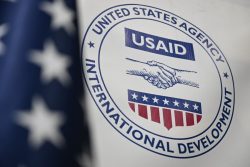Introduction
As President Jagdeo prepares to demit office in another few weeks there is a single issue with which his name will always be associated in CARICOM. And that is the common regional agricultural repositioning strategy which has been given the name Jagdeo Initiative. That it will remain only an initiative without any success is evident by Jagdeo’s failure to carry through his initiative even in his own country. Quite what is the Jagdeo Initiative and how did it arise?
 In 2002 President Jagdeo had said to the leaders of CARICOM that agriculture had been buckling under pressures of trade reform, natural disasters and policy deficiencies; that the region had a poor implementation track record with the result that agriculture was not providing the region with food security nor covering the growing food import bill. He told his colleagues “… at this stage, we need a policy and strategy which will allow us to decide on what sort of institutions and mechanisms are needed to reposition agriculture.”
In 2002 President Jagdeo had said to the leaders of CARICOM that agriculture had been buckling under pressures of trade reform, natural disasters and policy deficiencies; that the region had a poor implementation track record with the result that agriculture was not providing the region with food security nor covering the growing food import bill. He told his colleagues “… at this stage, we need a policy and strategy which will allow us to decide on what sort of institutions and mechanisms are needed to reposition agriculture.”
The region’s leaders were taken in by the self-confidence of the young Guyanese leader and taking him on his word rather than by his action, made him Lead Head responsible for Agriculture in CARICOM.
IICA and FAO recruited
Thereafter it was all bureaucracy and talk with nothing to show for it. Apart from the resources which he had at his disposal within Guyana’s own oversized and expensive Ministry of Agriculture, Jagdeo was also able to call on the Inter-American Institute for Co-operation on Agriculture (IICA) and the Food and Agriculture Organisation of the United Nations (FAO) to assist in developing a framework towards a common regional agricultural repositioning strategy. This included:
• A situation & Outlook Report (May/03) establishing the challenges and requirements of repositioning
• A Ministers of Agriculture Forum (June/03) which supported the renewed call for action and the Jagdeo Initiative.
• And in July 2004, the Caribbean Heads of Government endorsed the first Proposal containing the Initiative’s vision, scope, focus and process.
Vision
Under the Jagdeo Initiative, by 2015, agriculture in the region will have “made substantial progress in its contribution to sustainable growth, within a framework of transparent institutions and good governance that enables the transformation of its products and processes, encourages investment, drives entrepreneurship and assures an acceptable and consistent level of food security.”
Scope and process
The scope of the initiative is to define and implement Interventions to address Key Binding Constraints within the context of the Community Agricultural Policy; Existing and planned complementary initiatives undertaken by national, regional and international organizations; Emphasis on non-traditional products, value-added and intensification of diversification and practical programmes with achievable targets.
The process comprised regular briefing meetings; establishing the context, scope and output of consultations; National Consulta-tions redefining the challenges, opportunities and requirements, regular workshops developing consensus on Key Binding Constraints, framework of Interventions and draft of 2nd Proposal to the Heads of Governments.
The process was to have received validation by the regional private sector and endorsed by the Agriculture Ministers in Jan 2005 and agreed by the Heads of Government in February 2005. For the next several months leading into 2006 there was supposed to be an Inventory of Interventions at National and Institutional Levels.
Overall responsibility for the Initiative was vested in President Jagdeo, with the next line down being the regional Ministers of Agriculture, Ministerial Delegates, Other Stakeholders.
Early criticisms
It seems that at some point around 2005/2006 Jagdeo lost interest in his own initiative and in fact did not even attend a High Level Symposium on the CSME held in June 2006 in Barbados. At the Symposium, Director of Operations and Integration for the Caribbean Region Mr. H. Arlington Chesney in a power point presentation described the initiative, somewhat harshly, as “not a perfect instrument; not a scholarly piece of work; evolving; a kick start and a vision and framework for all”.
Then in October 2010, Mr. Sergio Garcia, the CARICOM Programme Manager for Agriculture described in less than complimentary terms the series of earlier food initiatives that have languished in the region. Those initiatives of which the Jagdeo Initiative was the most recent, were described by Mr. Garcia as having “had limited, if any, success, however, because they have been prepared and executed in isolation from other policies. Actions taken have thus been sparse, diffuse… and uncoordinated.”
Jagdeo and his
lead Minister
Mr. Garcia might not know it but that is characteristic of several of the initiatives undertaken by the Jagdeo Administration. Jagdeo also did not help his own cause by having a Minister of Agriculture who was no more focused that he was.
To address the problems of agriculture and food security both regionally and nationally required not only a realistic vision but focus, commitment and sustained work. Instead of these, Jagdeo and his current Minister of Agriculture Robert Persaud MBA seem to prefer politics and propaganda with the latter thinking it was all about pepper, papaw, pumpkin and pineapple! Are these guys for real?
That knowing the problem is half the solution did not apply to Jagdeo and his Initiative and consequently it barely advanced beyond the identification of “binding constraints” which any desk exercise could have produced. Paradoxically the Jagdeo Initiative farmed out many of the responsibilities for addressing these constraints to the other CARCOM territories with only a single task assigned to Guyana and even then only jointly with the Caribbean Agricultural Research and Development Institute (CARDI).
Trinidad
While Guyana’s food bill has trebled since the President came up with his initiative, other countries in the Caribbean have long since dispensed with the initiative. In 2008, then Trinidad and Tobago Prime Minister Patrick Manning said that his country could not “wait for others to lead the way” and that Trinidadians must produce more and consume less; and above all else “we must move towards the highest possible level of food production…”
While Jagdeo speaks disparagingly of the closure of sugar estates in the Caribbean, Manning saw it as “liberating thousands of acres of arable land for food production.” Contrary to what Jagdeo has said about Trinidad, that country has announced the availability of two-acre plots of land to six thousand new farmers and the creation of seventeen new large farms, all of no less than one hundred acres each. That in a country that could fit many, many times into Guyana.
This past week, CARDI hosted in Trinidad Dr S. Ayyappan, Director General of the Indian Council of Agricultural Research (ICAR) a public lecture on how agricultural research and development in India helped to reduce hunger in that country. It would have been very useful for Guyana to have invited Dr. Ayyappan to visit Guyana to do a similar talk here and meet with officials but perhaps the campaign agenda did not allow for distractions by such developmental issues.
Jamaica
In Jamaica both the Government and the private sector have demonstrated what could be achieved with national initiatives. While in Guyana the agricultural bank was shut down and NIS money was allowed out for Mr. Duprey’s CLICO, Jamaica was more sensible. There the Export/Import (Ex-Im) Bank of Jamaica is teaming up with the Scientific Research Council (SRC) to collaborate on ideas, and with the National Insurance Scheme for the establishment of special financial facilities aimed at boosting agro-industrial production.
Such financing has been used in SRC-produced technologies in activities that include drying and the preservation of foods, particularly spices and teas; those for smoking, in the case of meats; and canning and concentrate applications, in the case of fruit and vegetable processing. And the Jamaican regional giant GraceKennedy Limited has only just launched the Grace Fresh n’ Ready brand of processed vegetables and official handing over ceremony of a J$43 million post-harvest processing plant in that country. The plant was leased from the Ministry of Agriculture. The facility was the result of a multi-lateral partnership known as the Improving Jamaica’s Agricultural Productivity Project (IJAP) – which received funding from the Canadian International Development Agency (CIDA) – the Ministry of Agriculture and the Inter-American Institute for Cooperation on Agriculture (IICA) and GraceKennedy Ltd.
Conclusion
There must be some realistic doubt whether at some stage Mr. Jagdeo will prepare a status report on his Initiative on which CARICOM was led into spending lots of scarce money.
The silent and dormant agro-processing/packaging plants at Parika and Sophia testify to Guyana’s failure to address its mounting food bill and exploit its huge potential in agricultural products. There must be a sense of both relief and sadness among Guyanese that other Caribbean countries long ago realised that under Jagdeo the region’s agricultural initiative was going nowhere.
Sadness that Guyana blew a wonderful and historic opportunity to stamp its valuable contribution on CARICOM: relief that the other countries did not rely on our President to help them solve their food problems. They would still be waiting.
Meanwhile when I asked a couple of friends about what they know about the Jagdeo Initiative, the most polite response was what is that? One said the LCDS, while another said Amaila. Oh, well.








